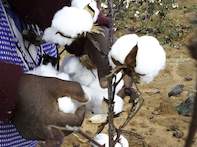The cotton species Gossypium hirsutum is grown in South Africa and was first introduced in 1690. In South Africa Cotton production reached a peak in the 1860s - 1870s when it was farmed in the Western Cape and KwaZulu-Natal provinces.

In the 1920s the first ginnery was established in Barberton in Mpumalanga and it was officially declared an agricultural crop in 1939. Around the late 1960s about 80% of cotton came from irrigation farms near Loskop, Vaalharts and Upington. South Africa’s largest ginnery is Loskop Cotton Gin, near Marble Hall in Limpopo.
Cotton farming in South Africa is a summer crop. It is planted from October to the end of November and harvested in May - June. Planting time depends on the region, climate (soil temperature) and particularly the rainfall in the area.
The Fall and Rise of Cotton Farming
In the late 1980s South Africa produced about 80 000 tons of cotton lint but by 2012, production was down to 5 300 tons. However, an integrated partnership programme was formed to include the whole South African cotton industry, from farmers to retailers and was funded by the Department of Trade and Industry (the dti).
This resulted in a growth in the South African Cotton Industry and an 800% increase in cotton production over a five year period from 2014 - 2019.
Cotton SA’s latest 2018/19 production forecast indicated a cotton crop of 48 000 tons of lint, an increase of 31% over the previous season. This is mainly due to the more favourable prices of cotton compared to competitive crops but also due to renewed interest in cotton production.
Farmland, both dry and irrigated has increased by 42% and 22% respectively in 2018/2019 from the previous season. Increase in cotton production in South Africa was seen in traditionally maize-planting areas such as Schweizer-Reneke in the North West but also in new areas in the Free State.
The industry has about 250 commercial farmers and more than 2 000 black small growers. South Africa’s cotton-growing areas are mainly located in Limpopo, Northern Cape, North West, KwaZulu-Natal and Mpumalanga. Cotton farming in South Africa forms part of the crop rotation practises for many farmers. A fact, not commonly communicated, is that cotton can reduce the carbon footprint. Cotton has a better than neutral carbon footprint because the plant stores more carbon in its lint and seeds than is released from fuel and fertilisers used during the growth period.
South African Cotton
South Africa produces high quality, exportable cotton that complies with the Better Cotton Initiative (BCI), a non-profit that promotes better standards in cotton farming and practices. Approximately 80% of the cotton lint is exported to various countries, including SADC countries such as Mauritius, Lesotho and Botswana as well as India, Bangladesh and China.
Although cotton still faces competition with other summer crops, it is less challenging than in the past. Cotton has become a prominent crop for planting because of its hardiness and profitability. Challenges for the cotton industry include crop rotation, insufficient seed availability with planting time and climate conditions - unfavourable weather conditions before and after planting.
The South African cotton industry is supported by Cotton SA which provides training, publishes monthly market, production and harvest statistics and promotes all aspects of the cotton industry.
By Marinda Louw